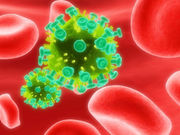Clinical manifestations of acute HIV-1 infection common just before and at time of peak viremia
WEDNESDAY, May 18, 2016 (HealthDay News) — Few symptoms and signs are observed during acute HIV-1 infection, and these are most common before peak viremia, according to a study published online May 18 in the New England Journal of Medicine.
Merlin L. Robb, M.D., from the Walter Reed Army Institute of Research in Silver Spring, Md., and colleagues performed twice-weekly qualitative plasma HIV-1 RNA nucleic acid testing in 2,276 volunteers at high risk for HIV-1 infection.
Fifty of 112 volunteers with acute HIV-1 infection had two or more blood samples collected before HIV-1 antibody detection. The researchers found that the median peak viremia occurred 13 days after nucleic acid testing reactivity appeared in the first sample. At a median of 14 days, reactivity on an enzyme immunoassay occurred. At a median of 31 days, the nadir of viremia occurred, which was nearly equivalent to the viral-load set point, the steady-state viremia that persists durably after viremia resolution. There was a correlation between peak viremia and downslope with viral-load set point. Just before and at the time of peak viremia, clinical manifestations of acute HIV-1 infection were most common. A median of one symptom of acute HIV-1 infection and one sign of acute HIV-1 infection were recorded at a median of two and three visits, respectively.
“During the acute phase, identification of cases of HIV-1 on the basis of clinical criteria may prove to be difficult,” the authors write.
Copyright © 2016 HealthDay. All rights reserved.








